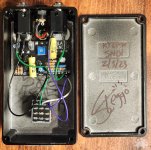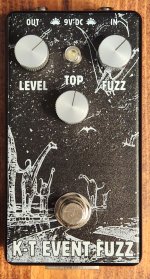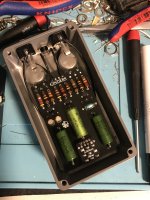Fingolfen
Well-known member
- Build Rating
- 5.00 star(s)
Back in December I finished up a clone of the EQD Black Ash fuzz pedal. For that first validation build I went with all modern components, but the original Black Ash used a lot of vintage bits in its construction - including carbon composition resistors and what appear to be paper in oil capacitors. I wanted to experiment with the components a bit and decided to try to take the build a few steps closer to the original to see if it made much difference.

Starting with the South Obolon FX board, the resistors are all carbon film, rather than metal film which gets me at least a step closer to the original. I may try yet another version with actual Allen Bradley carbon composition resistors, but from my previous experience with Big Muff pedals, I know that carbon composition resistors tend to raise the noise floor of the effect. One problem I ran into is the diagrams show that the Black Ash used both a 4.6K ohm and 46K ohm resistor. Because of the looser tolerances of carbon film and carbon composition resistors, as far as I've been able to find these values don't actually exist (potentially as they are within the tolerance of a 4.7K ohm and 47K ohm resistor). If anyone knows otherwise, please let me know! Looking at gut photos of the actual effect pedal, it is hard to tell whether or not the bands on those resistors are actually yellow-blue (indicating 4 - 6) as opposed to yellow-purple (indicating 4 - 7). I'm assuming the latter, and if the values are actually supposed to be 4.6K ohm and 46K ohm, they were hand selected to be at the low end of the range - which is exactly what I did for this build!

The original Black Ash didn't have too many capacitors. There were two axial electrolytic capacitors, which I think I've replicated. There was also only polystyrene capacitor, again which I think I've replicated. Finally there were a couple of what appear to be large paper-in-oil 100nF capacitors. I didn't go completely crazy there, though I did use higher-voltage Vishay capacitors similar to what the Tone Geek recommends on his TSV808 clone (the Steggo Secret Spinosaurus). I was a bit concerned that the larger capacitors wouldn't fit in the enclosure as the holes for the potentiometer shafts were very close to the top of the enclosure (in case I wanted to add a battery at some point), but with a little judicious placement, I managed to get everything to fit. I did go ahead and insulate the legs of the uppermost Vishay capacitor as it ran over both the edge of the board and on top of a few of the resistors. The transistors are all NOS 2N3903 transistors which were biased to 4.5V using the bias pad on the PCB.

There are enough ground pads on the PCB for me to route all of the jack grounds to the board itself rather than using a star ground to the input jack. All of the jack connections are insulated with heat shrink tubing, and I'm using a PedalPCB 3PDT daughter board for the stomp switch. The LED is hand wired.
The enclosure art is the same as the normal K-T Event Fuzz pedal, though I am using different knobs. In terms of the sound, I honestly need to play with it more. At high volume and fuzz settings there may be a bit of a difference, but I need to get it into my tube amps rather than just the Katana at 0.5W to give it a real test. I'm calling this version the "Mojo" edition - though that begs the question of what I'd call one with carbon composition resistors and paper-in-oil capacitors, but fortunately I can procrastinate a bit on that decision!
So, was it worth it? I guess it depends on your perspective. If "worth it" means it has a drastically different sound, then the jury's still out. I'm going to have to experiment with it more on different amps with different guitars (oh dang, make me play guitar!). The cost of this build isn't that much different than the all-modern component one - at least at this point. I could see how you could go completely crazy with exotic capacitors, though. In terms of "rule of cool" it definitely wins there, and it was a lot of fun to try and get all of the larger components to fit in the board's footprint.
Original blog entry: https://steggostudios.blogspot.com/2023/02/new-black-ash-variant-closer-to-original.html

Starting with the South Obolon FX board, the resistors are all carbon film, rather than metal film which gets me at least a step closer to the original. I may try yet another version with actual Allen Bradley carbon composition resistors, but from my previous experience with Big Muff pedals, I know that carbon composition resistors tend to raise the noise floor of the effect. One problem I ran into is the diagrams show that the Black Ash used both a 4.6K ohm and 46K ohm resistor. Because of the looser tolerances of carbon film and carbon composition resistors, as far as I've been able to find these values don't actually exist (potentially as they are within the tolerance of a 4.7K ohm and 47K ohm resistor). If anyone knows otherwise, please let me know! Looking at gut photos of the actual effect pedal, it is hard to tell whether or not the bands on those resistors are actually yellow-blue (indicating 4 - 6) as opposed to yellow-purple (indicating 4 - 7). I'm assuming the latter, and if the values are actually supposed to be 4.6K ohm and 46K ohm, they were hand selected to be at the low end of the range - which is exactly what I did for this build!

The original Black Ash didn't have too many capacitors. There were two axial electrolytic capacitors, which I think I've replicated. There was also only polystyrene capacitor, again which I think I've replicated. Finally there were a couple of what appear to be large paper-in-oil 100nF capacitors. I didn't go completely crazy there, though I did use higher-voltage Vishay capacitors similar to what the Tone Geek recommends on his TSV808 clone (the Steggo Secret Spinosaurus). I was a bit concerned that the larger capacitors wouldn't fit in the enclosure as the holes for the potentiometer shafts were very close to the top of the enclosure (in case I wanted to add a battery at some point), but with a little judicious placement, I managed to get everything to fit. I did go ahead and insulate the legs of the uppermost Vishay capacitor as it ran over both the edge of the board and on top of a few of the resistors. The transistors are all NOS 2N3903 transistors which were biased to 4.5V using the bias pad on the PCB.

There are enough ground pads on the PCB for me to route all of the jack grounds to the board itself rather than using a star ground to the input jack. All of the jack connections are insulated with heat shrink tubing, and I'm using a PedalPCB 3PDT daughter board for the stomp switch. The LED is hand wired.
The enclosure art is the same as the normal K-T Event Fuzz pedal, though I am using different knobs. In terms of the sound, I honestly need to play with it more. At high volume and fuzz settings there may be a bit of a difference, but I need to get it into my tube amps rather than just the Katana at 0.5W to give it a real test. I'm calling this version the "Mojo" edition - though that begs the question of what I'd call one with carbon composition resistors and paper-in-oil capacitors, but fortunately I can procrastinate a bit on that decision!
So, was it worth it? I guess it depends on your perspective. If "worth it" means it has a drastically different sound, then the jury's still out. I'm going to have to experiment with it more on different amps with different guitars (oh dang, make me play guitar!). The cost of this build isn't that much different than the all-modern component one - at least at this point. I could see how you could go completely crazy with exotic capacitors, though. In terms of "rule of cool" it definitely wins there, and it was a lot of fun to try and get all of the larger components to fit in the board's footprint.
Original blog entry: https://steggostudios.blogspot.com/2023/02/new-black-ash-variant-closer-to-original.html
Last edited:


